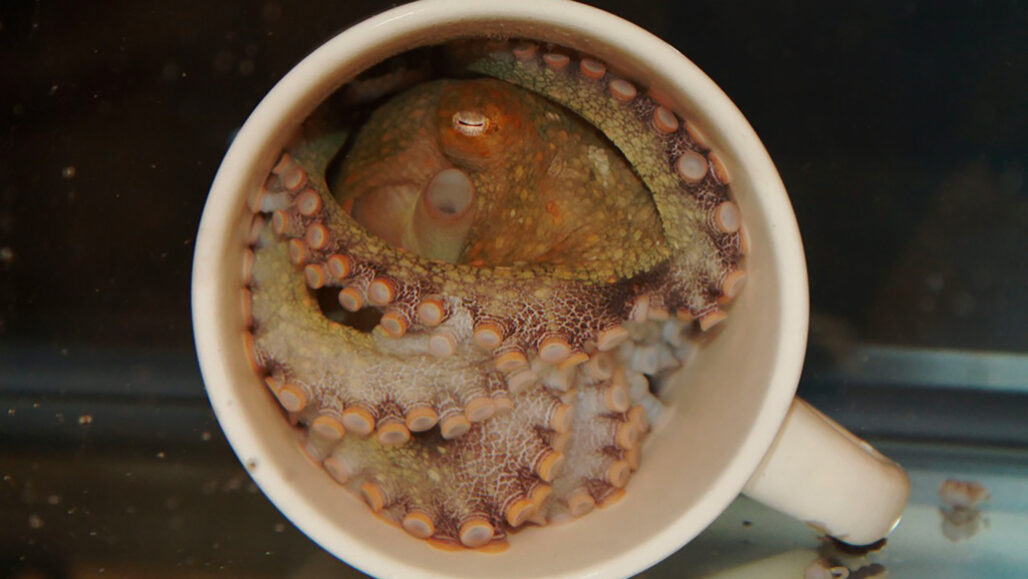Touching allows octopuses to pre-taste their food
Special cells in the animal’s suckers can identify what’s safe to eat

A California two-spot octopus (Octopus bimaculoides) rests in a coffee mug in a Harvard University lab. Researchers have discovered sensory cells embedded in octopus suckers that are unlike those in other animals. These cells taste by touch.
Lena van Giesen
Octopus arms have minds of their own.
Their eight powerful limbs can pluck crusty crabs from hiding spots. They can grab hold of a lazy lobster. They can snag a frolicking fish. And they do all this without using their brains. That’s because their arms can think for themselves.
Oh, one other thing: An octopus can use those arms to “taste” food, although not quite as people do.
Researchers have just found specialized cells on the arms of octopuses. These cells, which allow the animal to taste food, have not been seen in other animals.
“There was a huge gap in knowledge of how octopus [arms] actually collect information about their environment,” says Tamar Gutnick. She’s a neurobiologist who studies octopuses at Hebrew University of Jerusalem in Israel. She was not involved in the study. “We’ve known that [octopuses] taste by touch,” she says. However, she adds, “Understanding how it’s actually working is a very different thing.”
How the arms sense and process information is key to understanding octopus intelligence, she says. “It’s really exciting to see someone taking a comprehensive look at the cell types involved” — and how they work.
Super-sensitive arms
Octopus arms attach to the animal’s head. The creature uses these arms to move, hunt and mate. Each arm has 280 suckers. Embedded in each sucker are special cells. Those cells may help an arm quickly tell whether something is a morsel of food, a spiny rock or a poisonous creature. To do this, they not only feel prey, but also taste it.
These cells detect chemicals produced by many aquatic animals, explains Nicholas Bellono. He’s a molecular biologist, someone who studies the cells of life. He headed a team at Harvard University in Cambridge, Mass., that has just made a study of these cells. What they found is a clue to the unique path that octopuses have evolved toward intelligence.
A whopping two-thirds of the nerve cells in an octopus reside in its arms, not its brain. All those cells allow these flexible feelers to operate almost on their own.
The Harvard group focused on the arms of the California two-spot octopus (Octopus bimaculoides). They took detailed pictures. These showed what appeared to be sensory cells. Some of those cells on the surface of the suckers had endings that branched out like a tree.
Bellono’s team isolated the cells, then tested how these responded to a number of stimuli. This might be pressure. Or it might be a chemical extracted from some fish. One class of cells were similar to those that detect touch in many animals. Another set responded to the fish extract.
Bellono’s group found that the second set of cells contained receptors — proteins that sense specific stimuli. No other animal is known to have this type of receptor. He describes them as “chemotactile” (KEE-moh-TAK-tyle), meaning they can tell one chemical from another by touch.
Homing in on the tasters
To study how those receptors worked, Bellono and his crew inserted them into cells from humans and frogs. They did this using genetic tools. They then exposed the cells to a range of different chemicals that an octopus might encounter. The cells responded to only one group of chemicals. They’re known as terpenoids (TUR-peh-noydz). Many marine creatures make these. Scientists think some of them use these as a poison to defend themselves against predators.
At first, the finding struck Bellono as somewhat odd. “For aquatic sensation, we usually think of molecules that diffuse well through water,” he says. That would be similar to how humans smell compounds that diffuse through air. But these terpenoids didn’t dissolve well in water. Then Bellono realized this made a lot of sense. Octopuses move through their watery world “by touching everything,” he notes. Terpenoid detectors might cue an octopus to quickly grasp something it touches before it swims away — or to let go and keep searching.
And that’s exactly what happened in the lab. While they were in a tank, the octopuses explored normal surfaces without terpenoids using broad, sweeping arm movements. But once an arm touched a surface filled with different terpenoids, the animals stopped. They then quickly tapped the spot and moved on — or quickly swam away, avoiding that part of the tank.
It’s not clear just what these behaviors mean. What they do tell us is that octopuses use these receptors to sense chemicals by touch. “We equate it to taste by touch just so that we can sort of understand what it might mean to the octopus,” says Bellono. “But,” he adds, “it’s very different than our taste.”
His lab is already working on identifying other compounds that these sensors can detect. Bellono also is investigating how the receptors might be tuned to respond to different sorts of stimuli depending on the context, such as how hungry an octopus might be.







